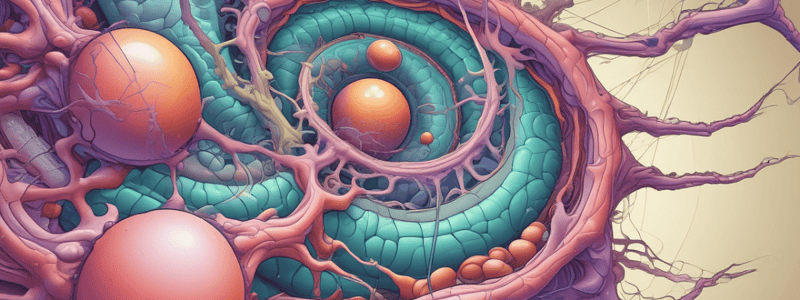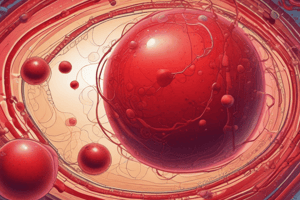Podcast
Questions and Answers
What are the three basic structures of a cell?
What are the three basic structures of a cell?
- Cytoplasm, Ribosomes, Cell wall
- Rough ER, Smooth ER, Cell membrane
- Cell membrane, Cytoplasm, Organelles (correct)
- Nucleus, Ribosomes, Cytoplasm
Which type of membranes line the body cavities that are connected to the external environment?
Which type of membranes line the body cavities that are connected to the external environment?
- Cutaneous membranes
- Mucous membranes (correct)
- Serous membranes
- Synovial membranes
What type of epithelium makes up serous membranes?
What type of epithelium makes up serous membranes?
- Stratified squamous epithelium
- Simple squamous epithelium (correct)
- Cuboidal epithelium
- Pseudostratified columnar epithelium
Which of the following statements about synovial membranes is correct?
Which of the following statements about synovial membranes is correct?
What is the role of special cells in mucous membranes?
What is the role of special cells in mucous membranes?
What are the two types of membranes mentioned?
What are the two types of membranes mentioned?
Which of the following structures is NOT a part of the cellular architecture?
Which of the following structures is NOT a part of the cellular architecture?
Which term refers to the outer surfaces of organs that are lined with serous membranes?
Which term refers to the outer surfaces of organs that are lined with serous membranes?
Which of the following statements about the structure of biological membranes is TRUE?
Which of the following statements about the structure of biological membranes is TRUE?
What is the primary function of transmembrane proteins in biological membranes?
What is the primary function of transmembrane proteins in biological membranes?
Which of the following is NOT a characteristic of peripheral membrane proteins?
Which of the following is NOT a characteristic of peripheral membrane proteins?
Which of the following statements accurately describes the movement of membrane proteins?
Which of the following statements accurately describes the movement of membrane proteins?
What is the role of ATP hydrolysis in membrane transport?
What is the role of ATP hydrolysis in membrane transport?
How do the hydrophobic tails of phospholipids contribute to the structure of the cell membrane?
How do the hydrophobic tails of phospholipids contribute to the structure of the cell membrane?
Which of the following molecules would be most likely to diffuse freely across the lipid bilayer of a cell membrane?
Which of the following molecules would be most likely to diffuse freely across the lipid bilayer of a cell membrane?
How do integral membrane proteins contribute to the diversity of membrane functions?
How do integral membrane proteins contribute to the diversity of membrane functions?
Which of these functions is NOT associated with membrane proteins?
Which of these functions is NOT associated with membrane proteins?
What is the primary function of the lipid layer in the cell membrane?
What is the primary function of the lipid layer in the cell membrane?
Which of the following statements is TRUE about the cell membrane's selective permeability?
Which of the following statements is TRUE about the cell membrane's selective permeability?
Which of the following is NOT a function of proteoglycans in the cell membrane?
Which of the following is NOT a function of proteoglycans in the cell membrane?
What is the role of transmembrane proteins in cell-cell binding?
What is the role of transmembrane proteins in cell-cell binding?
What is the main function of carrier proteins in the cell membrane?
What is the main function of carrier proteins in the cell membrane?
Which of the following is a function of glycoproteins in the cell membrane?
Which of the following is a function of glycoproteins in the cell membrane?
Which of the following is NOT a characteristic of the cell membrane?
Which of the following is NOT a characteristic of the cell membrane?
Which of the following statements is NOT true about ribosomes?
Which of the following statements is NOT true about ribosomes?
Which of the following is NOT a function of the Golgi apparatus?
Which of the following is NOT a function of the Golgi apparatus?
What is the primary function of lysosomes?
What is the primary function of lysosomes?
What type of enzymes are found within lysosomes?
What type of enzymes are found within lysosomes?
Which of the following is NOT a component of the Golgi apparatus?
Which of the following is NOT a component of the Golgi apparatus?
What is the role of ribosomes in protein synthesis?
What is the role of ribosomes in protein synthesis?
Which of the following is a function of the Golgi apparatus in relation to the cell membrane?
Which of the following is a function of the Golgi apparatus in relation to the cell membrane?
What is the role of lysosomes in the breakdown of degenerated cell organelles?
What is the role of lysosomes in the breakdown of degenerated cell organelles?
Which of the following statements accurately describes the relationship between the cisternal space and the cytosol?
Which of the following statements accurately describes the relationship between the cisternal space and the cytosol?
Which of these functions is NOT directly associated with the rough endoplasmic reticulum (RER)?
Which of these functions is NOT directly associated with the rough endoplasmic reticulum (RER)?
Which of the following is a primary function of the smooth endoplasmic reticulum (SER) in hepatocytes (liver cells)?
Which of the following is a primary function of the smooth endoplasmic reticulum (SER) in hepatocytes (liver cells)?
Which of these statements accurately describes a key function of the SER in the detoxification process?
Which of these statements accurately describes a key function of the SER in the detoxification process?
Which of the following is NOT a function of mitochondria?
Which of the following is NOT a function of mitochondria?
Which of the following is a TRUE statement about the structure of mitochondria?
Which of the following is a TRUE statement about the structure of mitochondria?
Which of the following accurately describes how the SER contributes to the formation of chylomicrons?
Which of the following accurately describes how the SER contributes to the formation of chylomicrons?
Which of these statements about the function of the SER in muscle cells is correct?
Which of these statements about the function of the SER in muscle cells is correct?
Flashcards are hidden until you start studying
Study Notes
Cell Structures
- A cell consists of three basic structures: plasma membrane, cytoplasm, and organelles
Membranes
- There are two types of membranes: epithelial and connective tissue membranes
- Epithelial membranes include:
- Cutaneous membranes
- Serous membranes
- Mucous membranes
- Serous membranes:
- Line the inner face of body cavities not connected to the external environment
- Consist of a simple, squamous epithelium (mesothelium) lined up on a thin connective tissue
- Secrete a serous fluid that wets the surface
- Mucous membranes:
- Line body cavities directly or indirectly connected to the external environment
- Special cells secrete mucus
- Synovial membranes:
- Line the joint space inside movable joints
- Do not contain a continuous epithelium
- Made up of flat connective tissue cells and adipose tissue elements
Cell Membrane
- The lipid bilayer forms the main structure of biological membranes
- Proteins in the membrane determine its function
- Proteins can be classified into two classes: peripheral proteins and integral proteins
- Integral proteins:
- Can be completely embedded in the lipid bilayer
- Can have parts that protrude towards the surface
- Can be embedded in the outer or inner half of the lipid bilayer
- Can extend across the lipid bilayer and meet the aqueous microenvironment on both sides of the membrane (transmembrane proteins)
- Peripheral proteins:
- Completely outside the lipid layer
- Do not constitute a continuous layer
- Functions of proteins in the membrane:
- Transport: form hydrophilic channels and transport substances across the membrane
- Enzyme activity: act as enzymes in metabolic pathways
- Signal transduction: allow signal molecules to bind and transmit messages to the cell
- Binding between cells: bind neighboring cells together
- Cell-cell recognition: enable cell recognition by other cells
- Attachment to the extracellular matrix: attach the cytoskeleton to the extracellular matrix
Carbohydrates of Membrane
- Proteoglycans are carbohydrates attached to the outer surface of the cell with small proteins
- Functions:
- Form recognition regions of the cell
- Create a negatively charged cell surface
- Make cells stick together
- Act as receptors
Functions of Cell Membrane
- Separate the cell from the external environment and control the entry and exit of matter
- Selective permeability: allow certain substances to enter the cell while keeping others out
- Ensure cell and organelle integrity
- Transport molecules across the membrane
- Initiate metabolic reactions
- Regulate metabolic reactions
- Bind cells together
Endoplasmic Reticulum (ER)
- Functions:
- Participate in protein synthesis
- Perform protein glycosylation
- Make quality control of proteins
- Selectively send synthesized proteins to other organelles to form their structure
- RER (Rough Endoplasmic Reticulum):
- Involved in protein synthesis, glycosylation, and quality control
- Sends proteins to other organelles to form their structure
- SER (Smooth Endoplasmic Reticulum):
- Involved in steroid hormone synthesis, glycogen production, cholesterol and bile production, detoxification, and storing calcium ions
Mitochondria
- A double-membrane organelle with variable numbers depending on the cell's function
- Contains unique DNA and ribosomes
- Functions:
- Acts as the energy (ATP) production center of the cell
- Stores excess calcium in the cytosol and returns it to the cell when necessary
- Plays a role in hormone synthesis
- Initiates apoptosis (programmed cell death)
Ribosomes
- Found individually or in groups on the surface of the cytosol-facing membrane of the RER, on the surface of the outer nucleus, and in the cytoplasm
- Made up of protein and ribonucleic acid (RNA) molecules
- Functions:
- Carry out protein synthesis
Golgi Apparatus
- Not found in prokaryotes and red blood cells
- Exchanges products synthesized in the cell and ensures they are transported to their destination by packaging
- Consists of three parts: flat sacs, secretory granules, and vacuoles
- Functions:
- Makes secretion
- Synthesizes glycoproteins
- Packages and concentrates secretions
- Forms lysosomes in the RER region
- Preserves membrane integrity by adding vesicles to the cell membrane by exocytosis
Lysosomes
- Defense and digestive organelle
- Contains degrading enzymes called hydrolase produced in the ER and Golgi complex
- Functions:
- Digests large molecule nutrients
- Digests bacteria, viruses, and toxins
- Releases calcium in bone
Studying That Suits You
Use AI to generate personalized quizzes and flashcards to suit your learning preferences.



